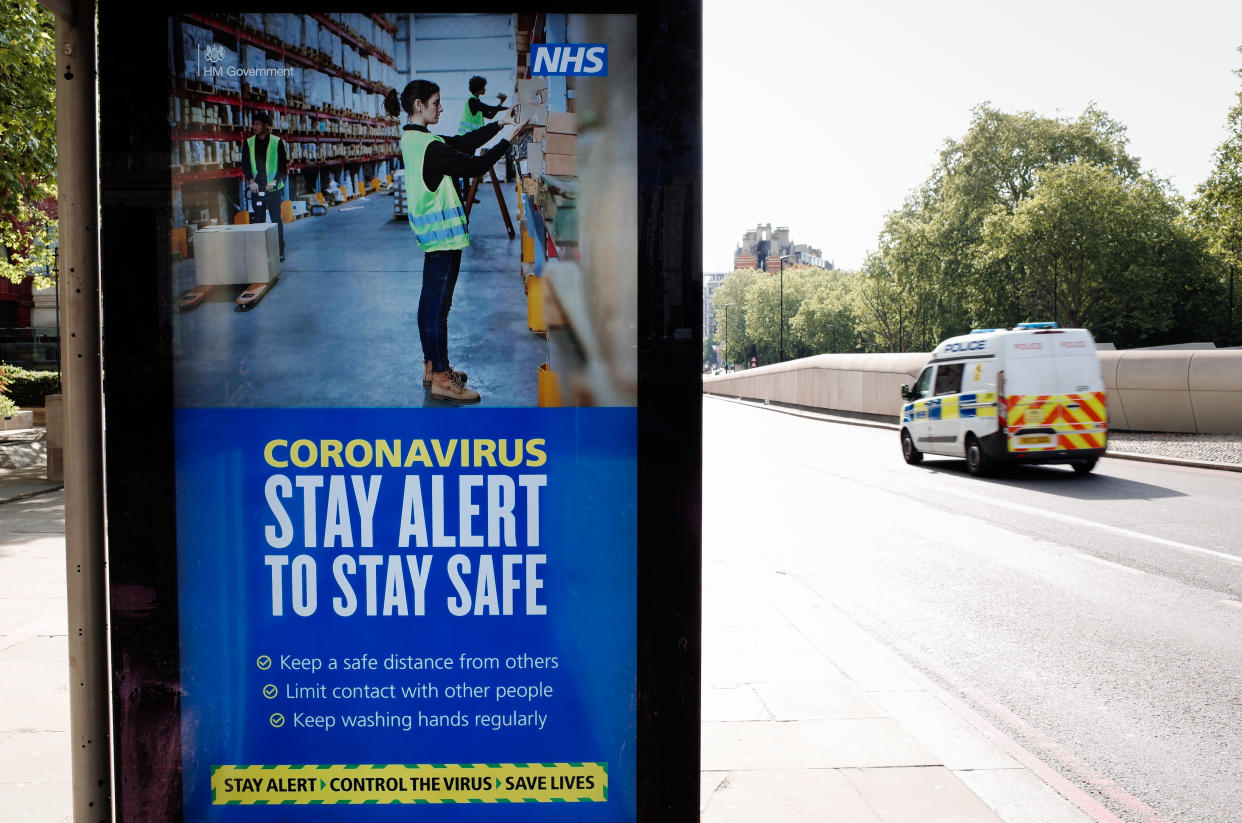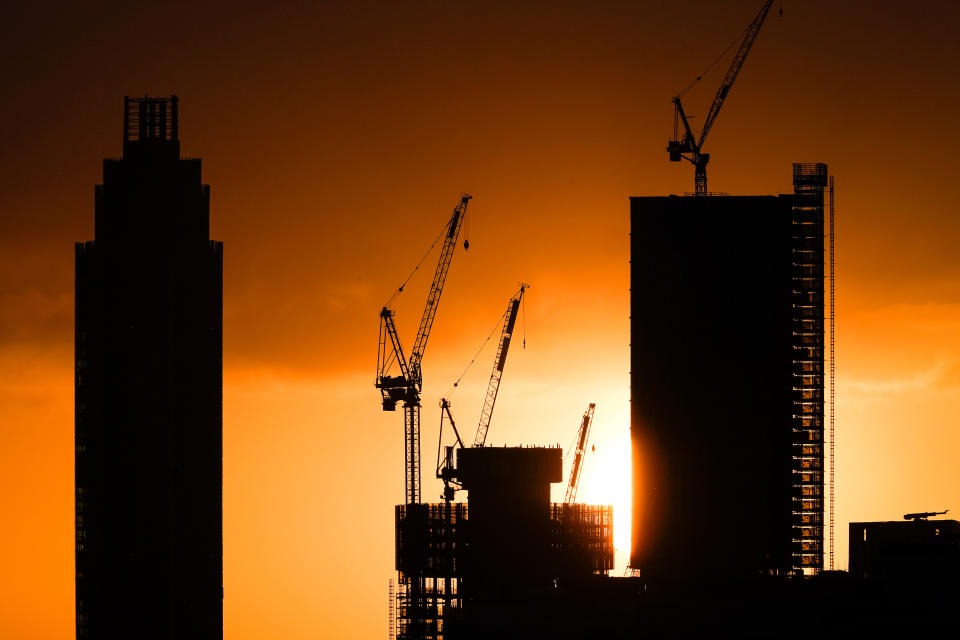Coronavirus spot checks on firms begin amid backlash over halted inspections

Government inspectors have now begun proactive visits to UK workplaces over coronavirus safety measures, with all employers warned they could face unannounced visits, Yahoo Finance UK can reveal.
But Labour called it “deeply concerning” that Health and Safety Executive (HSE) checks only began eight weeks after Britain went into lockdown, and that all proactive inspections for other safety issues were also suspended until last week.
Union and business leaders told Yahoo Finance UK the government should not have let construction and other high-risk sites stay open throughout lockdown, before such inspections and other safety measures were in place.
Shadow employment minister Andy McDonald also warned HSE “simply does not have the resources” to inspect many workplaces, after budget cuts over the past decade.
Stay at home — unless you work in construction
Within hours of Britain first going into lockdown on 23 March, it became clear to many construction workers the ‘stay at home’ message did not apply to them.
Housing minister Robert Jenrick tweeted shortly after the prime minister’s lockdown announcement that those working on construction sites “can continue to do so,” if social distancing guidelines were followed.
The government maintained its stance despite a backlash, with calls by Scotland’s first minister Nicola Sturgeon, London mayor Sadiq Khan, and many nervous workers warning sites should shut.
READ MORE: Fears over safety on building sites as Johnson urges Brits back to work
Advice for the housing, construction & building maintenance industries:
🔹If you can work from home, do so.
🔹If you are working on site, you can continue to do so. But follow Public Health England guidance on social distancing.
🔹Outside of work, remember to #StayHomeSaveLives— Robert Jenrick (@RobertJenrick) March 23, 2020
Less widely noticed at the time was that while the government wanted construction workers to be on sites as usual, it did not want all its own inspectors to do the same.
A subsequent message posted on the HSE’s website said it had “suspended targeted inspection activity of high-risk industries,” including construction and manufacturing.
Its staff began working remotely for their own safety. HSE said it would maintain inspections over specific complaints, but halt more proactive checks in sectors where industry-wide health and safety problems are common.
HSE has now confirmed to Yahoo Finance UK that such inspections are back underway.
“HSE has begun carrying out proactive checks to ensure that appropriate measures are in place to protect workers from COVID-19.” a spokesperson said. They added that HSE and council inspectors were also visiting “workplaces across a range of sectors” over reported issues to ensure compliance.
The Department for Business, Energy and Industrial Strategy was also approached for comment, but referred questions to HSE.
Sites open but not safe enough for inspectors
Proactive checks resumed only last week after almost two months of lockdown and more than a week after Johnson promised “random spot inspections.”
Officials now face mounting scrutiny of the decision to let even non-essential construction and manufacturing sites stay open without proactive inspections for so long in the first place.
“The government should not have encouraged construction and other high-risk workplaces to reopen when proactive inspections were not occurring,” said Gail Cartmail, assistant general secretary of Unite, which has called for checks for weeks. “If sites were not safe for inspectors then they were certainly not safe for construction workers,” she told Yahoo Finance UK.
It is clear many construction sites did actually stay open, before not just proactive checks but also COVID-19 testing and all government guidelines were rolled out for the sector.
READ MORE: UK under pressure to stop construction work
By the time Johnson eased the lockdown and promised random inspections alongside his ‘back to work’ message in early May, most sites were up and running. BuildUK figures show 73% of sites in England and Wales were up and running on 6 May.
Some closed initially to design and implement safety plans, with Taylor Wimpey, Vistry and Persimmon all highlighting their wide-ranging new measures on sites. But others remained open throughout.
Geoff Wilkinson, managing director of a London-based building standards firm, previously told Yahoo Finance UK some contractors “put pressure on subcontractors to continue to work.” Many firms risk penalties for delays to work. Many self-employed subcontractors also needed the money, with government grants only paid in late May and some workers ineligible.
More COVID-19 complaints and deaths among construction workers

Crucially, evidence is growing that workers may have faced serious risks on some UK sites.
Figures released to Yahoo Finance UK by HSE show it received 803 complaints about construction workplaces between 9 March and 7 May. They made up some 16.3% of complaints made in any sector and the second highest of any sector. Manufacturing had the most, with 1,073 complaints.
A spokesperson said over 60% of issues were resolved swiftly, with HSE satisfied by measures taken after it made enquiries. The remainder of complaints had been or were being investigated. “We are addressing all the concerns received.”
But the high number of complaints in construction and manufacturing suggests such issues could be widespread in these sectors. Many issues are likely to have gone unreported and thus undetected by authorities with proactive inspections paused.
"These figures demonstrate the government's muddled thinking when it comes to vital life saving inspections,” added Unite’s Cartmail.
Separate figures from the Office for National Statistics (ONS) also point to higher-than-average COVID-19 deaths among construction workers.
Official data in early May revealed ‘elementary workers’ had the highest male death toll from COVID-19 of nine major employment categories in the UK. Within this sub-group, construction workers had the third highest death rate, with 22 deaths with a reported link to the coronavirus by 20 April.
HSE says it also received 71 reports of COVID-19 deaths from employers by early May, where workplace exposure may have proved fatal. No breakdown by sector was available, however. “We are working hard... to help in the national response to the coronavirus outbreak including assessing those deaths that have been reported to us,” a spokesperson said.
Neither dataset proves construction workers fell ill through poor workplace standards; risks may have been on public transport or entirely unrelated to work. But the strong correlation means such a link is plausible, raising questions over whether more could have been done to limit infections and deaths.
‘Until inspections ramp up, site managers will be dismissive’

Such statistics come on top of considerable anecdotal evidence of problems in construction since before the lockdown even began. Social media was flooded with photos of workers huddled closely together on sites throughout March.
“Will history have it down that this government sent poor people back out to die? I think construction workers have been forgotten about,” one joiner told Yahoo Finance UK.
The joiner, who runs a small firm in the West Midlands, said he had taken his team off larger jobs where there were “no measures in place.”
Workers on one site were expected to work closely together on a 6ft wide scaffold tower, he said. Another was “exactly how it was pre-lockdown” when 30 men returned, except potential toilet overcrowding had been dealt with by slashing cubicle numbers from seven to two. Toilets were also only cleaned once a day. He was “not happy” with the risks, and warned a director they could both face prison if workers fell ill.
He said some sites were now at a “really high standard,” with two-metre lines across the floors and football-style ‘red card’ systems for behaviour. But other contractors lacked the budget for new facilities, or the ability to persuade clients to cover costs or accept delays as social distancing slows down work, he added.
READ MORE: Shopkeepers brace for uncertain reopening: ‘Life’s changed now forever’
He believes only essential projects like hospitals should have continued initially, and other firms should only have been able to restart once their safety policies had been approved by officials.
The long suspension of proactive inspections is particularly striking when construction was already one of the most dangerous industries before COVID-19. It has significantly higher injury rates, and almost one in three workplace deaths is in the sector. This is why it is typically a key priority area for HSE’s thousands of proactive inspections every year.
The joiner believes HSE should have been “ramping up inspections where they just drop in on sites” from the beginning. “Until they do, site managers will just be dismissive.”

‘All sectors are in scope for spot inspections’
Things are now changing, with HSE inspectors visiting sites from last week. “As businesses start getting back to work, we can see scope for making further proactive enquiries of employers,” said a spokesperson.
HSE has said traditional sectors are the priority, but it has now made clear for the first time that “all sectors are in scope for spot inspections” over COVID-19 measures.
A spokesperson said its approach will be “adaptable and regularly reviewed” as other sectors respond to COVID-19. “What we consider low risk in terms of conventional health and safety may well receive spot inspections.”
But HSE’s capacity and COVID-19’s effects on virtually every sector means it remains unclear if random checks can be widespread enough to be as effective as ministers suggest.
READ MORE: 60,000 complaints over UK price hikes and refund issues
Both HSE and councils, responsible for many lower-risk sectors, have lost hundreds of inspectors over the past decade in austerity cuts. The spokesperson said £14m ($17.2m) in new funding would boost capacity, but it has had £100m taken away since 2010. Officials were also ordered to rein in proactive checks on low-risk sectors over general safety issues under the coalition government.
Labour MP Andy McDonald told Yahoo Finance UK: “The pausing of inspections has been deeply concerning, so it’s reassuring that they have resumed and that all workplaces are now in scope for spot inspections, but any plans for returning to work outside the home are only as strong as their enforcement.
“The HSE simply does not have the resources to inspect workplaces effectively.”

 Yahoo News
Yahoo News 
